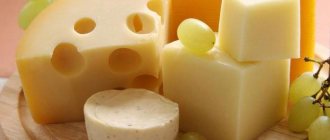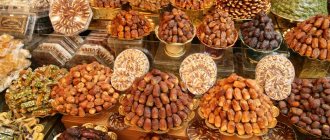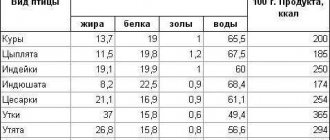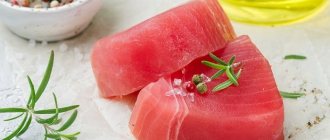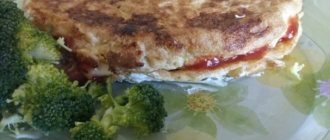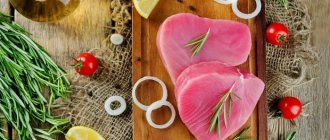Adyghe cheese is a soft brine cheese made from cow's milk. For its production, they do not use rennet (produced in the rennet glands of mammals), but a soft fermented milk starter. This makes the cheese accessible to vegans and vegetarians.
The taste and structure of the product are neutral, and therefore suitable for any dish. You can make a simple sandwich from bread and a piece of Adyghe cheese or add the product to soup, open/closed pie, salad, pizza, khachapuri, roll, puff pastry. The cheese is dense enough so as not to fall apart during rapid frying, but moderately soft so as not to spoil the structure of the baked goods.
The quality of dairy products is regulated by GOST, which strengthens the product’s position in the market. How to prepare Adyghe cheese and is it safe to include it in your daily diet?
General characteristics of the product
Content:
- General characteristics of the product
- Varieties of dairy product
- Chemical composition
- Use in cooking
- Features of industrial production
- How to make Adyghe cheese at home
- How to choose and store the product correctly
Adyghe or Circassian cheese is a national dish of the Circassian culinary tradition [1]. Its name was formed due to its territorial affiliation. The first industrial batches of cheese were produced in the Republic of Adygea by the Circassian population [2]. Cheese bars were made from whole goat or cow's milk. Later, as the industry became larger and more influential, producers switched to cow's milk to reduce the cost of production [3].
The product belongs to the category of soft cheeses without ripening. It has a muted sour milk taste, delicate texture and neutral aroma. There are only 2 variations of industrial dairy products: smoked and fresh. In the photo and even on store shelves, Adyghe cheese can easily be confused with mozzarella, feta cheese, ricotta, mascarpone or feta. But the main difference between the product produced by the Circassian people is pasteurization. The milk mixture is subjected to heat treatment, then fermented milk whey is introduced and the milk protein is allowed to precipitate. The external shape of the cheese is made primarily in the shape of a cylinder with convex side surfaces and rounded edges.
The taste of the product is clean, spicy, fermented milk. A sophisticated consumer will notice the specific taste of pasteurization and the subtle salty taste of whey protein. Its structure is moderately delicate, but not loose. The shade can vary from snow-white to light yellow. GOST allows individual cream spots on the surface of the bar and sections [4]. Adyghe cheese does not have a crust. Small slot-like voids and slight layering are allowed on the surface.
Origin story
The recipe is traditional for the Adyghe people. They called him "matekuae". The word is formed from combining the words “basket” and “cheese”; the product itself was often smoked. Smoking took place in a device that was usually used to fumigate hives with bees. This increased the shelf life of the finished product and imparted a smoky aroma and a piquant taste.
Note! The product received recognition thanks to the progress of M. Heishkho. In 1971, as the manager of the Adygei dairy plant, he proposed a preparation formula for mass production.
His application was reviewed and approved, and Heiksho himself was given a document - an author’s certificate for the “Method of Cheese Production.” The new technology gave impetus to the production and introduction of a new national dairy dish. Cheese making according to our own standard began 4 years later; similar techniques were used to create Adyghe cheese in the CIS countries. The production technology has not undergone any changes in the USSR; it has passed unchanged to GOST, according to which it is produced today.
The name “Adygei” comes not so much from the name of the republic, but from the name of the plant where the technology was invented. The ancestor of the product, matekuae, does not belong to industry; its production occurs in homes, within families and for household members. There is no single standard for preparing matekuae. Adyghe cheese, well known to the people, is a high-quality interpretation adapted for industrial production. The main difference is that the homemade dish of the Circassians is mainly based on sheep’s milk, while the industrial analogue is based on cow’s milk.
Varieties of dairy product
Important: industrial Adyghe cheese can be found throughout the post-Soviet space. Recipes may differ in each country. Moreover, a similar product can be sold under different trade names [5]. Be careful before purchasing.
Homemade Adyghe cheese, unlike industrial cheese, can be found in 3 different variations: fresh, dried and smoked. Fresh is practically no different from what is sold on supermarket shelves. However, a homemade product may contain rennet. If its presence/absence plays an important role for you, then be sure to check the information with the seller.
Smoked Circassian cheese has several names: red, Armavir or Kabardian. The product has gained particular popularity in the western part of the North Caucasus. It is smoked for several days until the crust becomes dense and impenetrable to bacteria or air. The shelf life of smoked dairy products is 6 months.
Dried Adyghe cheese is very similar to local kurt (fermented milk cheese balls). Since ancient times, this product served as food for shepherds, warriors and hunters. Dried cheese is very salty and hard. It retains only 20% moisture and 2% salt. Locals dry the bars in the shade, after which they are poured into huge boxes, covered with a layer of grain and sent to a barn with a stable temperature and stable humidity. Its shelf life can reach several years.
Interesting: before use, the dried head is doused with boiling water or dipped in boiling water. The product instantly becomes soft and pliable, but its structure is still denser compared to classic Adyghe cheese.
Tips for selection and storage
While in the store, you should look at:
- packing date (the cheese must be fresh, as it can be stored for no more than a month);
- absence of a peephole and crust on the surface of the cheese;
- moisture and shade of the outside (from pale white to light yellow);
- uniformity, absence of inclusions;
- the presence of yellow or pink spots (expiration date);
- fat percentage (the fattier the milk, the tastier the final product).
At home it should be noted:
- elasticity (when pressed, it returns to its original shape, but is not solid);
- pleasant milky smell, without ammonia impurities;
- soft, cheesy consistency, lack of dryness and excessive density;
- The slightly sour taste is combined with the smell of baked milk.
Storage:
- not subject to long-term storage (about 30 days from the date of packaging and no more than 1 week after opening);
- prevent the appearance of mold (consumption of such a product risks poisoning);
- protect from foreign odors (quickly absorbs other aromas);
- do not place it in the freezer (it loses some of its beneficial properties and begins to crumble);
- store in a glass or ceramic container with a tight-fitting lid;
- Smoked cheese can be stored for several months.
Chemical composition
Important: the product is prepared on the basis of pasteurized milk, whey and table salt. It is classified as a dietary food with high nutritional value and rich nutrient composition [6]. The mass fraction of fat in dry matter is 40%.
Nutritional value per 100 grams
| Calorie content [7] | 264 kcal |
| Squirrels | 19.8 g |
| Fats | 19.8 g |
| Carbohydrates | 1.5 g |
| Alimentary fiber | 0 g |
| Water | 56 g |
| Alcohol | 0 g |
| Cholesterol | 54 mg |
| Ash | 2.8 g |
Vitamin composition (in milligrams per 100 grams)
| Retinol (A) | 0,213 |
| Beta-carotene (A) | 0,1 |
| Tocopherol (E) | 0,3 |
| Ascorbic acid (C) | 0,2 |
| Thiamine (B1) | 0,04 |
| Riboflavin (B2) | 0,3 |
| Niacin (B3) | 0,3 |
| Nicotinic acid (PP) | 5,7 |
Concentration of minerals (in milligrams per 100 grams)
| Macronutrients | |
| Potassium (K) | 70 |
| Calcium (Ca) | 520 |
| Magnesium (Mg) | 25 |
| Sodium (Na) | 470 |
| Phosphorus (P) | 360 |
| Microelements | |
| Iron (Fe) | 0,6 |
Adyghe cheese: calorie content per 100 grams

Due to their moderate fat content, soft cheeses are not the most high-calorie foods. Thus, the energy value of 100 grams of Adyghe cheese is 254 kcal, which is 13-15% of the body’s daily needs. For weight loss diets, the plus is good: the human body is forced to use up internal fat reserves.
At the same time, in percentage terms, the daily intake of fat is satisfied by 44.7%, protein - by 23%. This balance balances the body's needs for building material for muscles and the energy value of the diet.
Use in cooking

Adyghe cheese is eaten as an independent snack or added to the following dishes:
- vegetable salads;
- rolls;
- pizza, khachapuri;
- soups;
- vareniki;
- cheese masses;
- pies and pies;
- cheese sauces;
- wrapped in puff pastry, lavash.
Fried cheese is especially popular. The structure of the product allows it to be subjected to all types of heat treatment. It can be fried in a regular frying pan or on the grill to give it a specific smoky flavor. Fry the cheese in a drop of vegetable oil for 1 minute on each side until a thick crust forms.
Fresh Adyghe cheese can replace suluguni, mozzarella and other types of soft dairy products [8]. Dried, it is best to grate into pasta, scrambled eggs or salad. You can prepare dried Circassian bars at home: leave the fresh product unpacked in the refrigerator, covering the surface with a linen napkin. In a month, dried Adyghe cheese will be ready.
Beneficial features
The benefits of the Adyghe fermented milk product are beyond doubt, because it:
- restores the functioning of the gastrointestinal tract and normalizes intestinal microflora;
- low calorie content allows you to reduce excess weight;
- useful for people with hypertension;
- improves sleep and reduces stress;
- preserves bone tissue, tooth enamel and healthy nails and hair;
- accelerates the decomposition of fats due to phosphorus;
- slows down cell aging by synthesizing collagen;
- fights viruses and removes toxins, improves immunity due to its zinc content.
We will tell you in this article what types of low-fat cheese there are.
You can read about the benefits and harms, calorie content and recipes of sausage cheese here
How to make cheese at home from cow's milk - read on our website
Features of industrial production
Interesting: cheese became a brand in 1980. It was during this period that its industrial production began. Since then, a cheese festival has been held annually in the city of Maykop (Republic of Adygea). During the holiday, locals organize themed fairs, dress up in ethnic outfits, and prepare many varieties of cheese.
How is the product prepared [9]? The milk mixture is heated to 95°C, after which fermented milk whey is introduced. Once the whey has curdled, the milk curds are collected in willow baskets. These baskets leave a beautiful, recognizable pattern on the sides of the Adyghe cheese. The head is formed in the same basket. This manufacturing method allows you to preserve the nutritional properties of the product and additionally disinfects it. The output is low cheese cylinders. Their weight does not exceed 2 kilograms. Their surface is convex and the edges are rounded. The ideal cylinder is stable and elastic when pressed, and the inside is tender and soft. The aroma of the product is very reminiscent of baked milk with a subtle sour taste.
Important: the price of the finished product may vary depending on the quality of the raw materials and the authority of the manufacturer [10]. The average market value is $6-10/1 kilogram.
How to pickle?
There are 3 ways to pickle cheese yourself:
- dry;
- in brine;
- combined;
The first method: you need to wipe the head of cheese on all sides with dry salt, the thickness of the layer should not exceed 1 mm.
Second: place the head of cheese in a brine consisting of one part salt and four parts boiled water with a small addition of 5 percent vinegar (1.33 ml per 1 liter of water). The cheese must be pressed down so that it does not float to the surface. And the top side should be additionally sprinkled with salt.
Third: the cheese is rubbed with dry salt for several days, and then placed in brine.
How to make Adyghe cheese at home
We will need:
- cow's milk - 2 liters;
- fermented milk product to taste (kefir/whey/yogurt) – 3 liters.
Best materials of the month
- Coronaviruses: SARS-CoV-2 (COVID-19)
- Antibiotics for the prevention and treatment of COVID-19: how effective are they?
- The most common "office" diseases
- Does vodka kill coronavirus?
- How to stay alive on our roads?
Preparation
Bring the milk to a boil, pour the fermented milk product into it and mix thoroughly several times. After some time, curd flakes will appear on the surface. As soon as this happens, turn off the heat. After a few minutes, the flakes will disappear and the serum will take on a clear or slightly greenish tint. Pour the finished mixture into a colander/sieve/special mold for making cheese. After 10 minutes, turn the mixture over and leave for 10-12 hours until the whey has completely drained.
The finished cheese can be salted or soaked in a solution of salt and spices, but this is optional. Brine solution recipe: 1 tablespoon whey + 3 tablespoons salt. Soak the cheese for 2-5 days, depending on the desired saltiness of the product. The aged mass must be placed in the refrigerator for 2-3 days, after which the snack is considered ready.
Curd
Curd cheese is rich in phosphorus (it helps bone tissue regenerate) and the following elements:
- calcium;
- iron;
- vitamins of group B and E;
- amino acids.
Cottage cheese:
- helps the gastrointestinal tract;
- improves metabolism;
- strengthens bones.
Cannot be used by people:
- with heart disease;
- with bad blood vessels;
- with high blood pressure.
Made from:
- fat milk (1 l);
- fat cottage cheese (1 kg);
- eggs (1 pc.);
- butter (120 g);
- soda (18 g);
- rock salt (20 g).
Step-by-step preparation:
- Boil milk in a thick-bottomed saucepan. When the first bubbles appear, add chopped cottage cheese and reduce heat to low. Cook for 15 minutes, stirring.
- After the curd becomes grainy and whey appears, separate it with gauze, squeeze it out and put it in a separate container.
- Combine with the remaining ingredients and mix until smooth.
- Melt the butter in a preheated bowl and stir until the mixture becomes sticky (about 15 minutes).
- Place the cheese in a container, cool and refrigerate for 5 hours.
Curd cheese can be made with dill or other herbs. Stored for a week.
Harm and contraindications
Despite its healing properties, Adyghe cheese, like any product, should not be overused. There are some contraindications:
- lactose intolerance;
- Excessive consumption can lead to obesity due to the high amount of saturated fat;
- the amino acid tryptophan contained in cheese, if consumed in excess, can lead to migraines, insomnia and nightmares;
- contraindicated for children under ten months;
- during lactation it can increase the fat content of milk;
- special forms of urolithiasis, excluding calcified foods;
- after the expiration date may cause poisoning.
